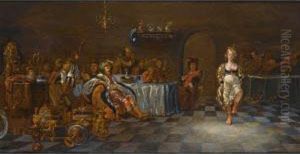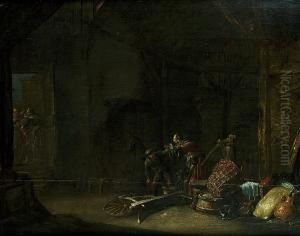Pieter Pietersz. I Vromans Paintings
Pieter Pietersz. I Vromans, also known as Pieter Pietersz the Elder, was a Dutch Renaissance painter born in 1540 in Haarlem, Netherlands. Not as widely known as some of his contemporaries, Vromans was part of the Northern Renaissance movement, which was characterized by a detailed approach to painting, with an emphasis on domesticity and everyday life.
Vromans' early life is not well documented, but it is known that he was active during the latter half of the 16th century, a period during which Dutch art saw significant development. His work was influenced by the likes of Pieter Bruegel the Elder and Hieronymus Bosch, artists known for their complex compositions and depiction of crowd scenes.
While historical records on Vromans are scarce, it is believed that he was a member of the Haarlem Guild of Saint Luke, an association of artists and craftsmen. His style suggests that he was trained in the local tradition, which valued precision and a naturalistic representation of scenes.
Vromans is primarily known for his religious works and portraits, although few of his paintings have been definitely attributed to him. His religious paintings often featured biblical scenes, rendered with an attention to human emotion and the use of color to enhance the narrative. His portraits, on the other hand, displayed a keen eye for detail and an ability to capture the personality and status of the sitter.
The artist's later life and career were likely impacted by the religious and political turmoil of the Eighty Years' War (1568–1648), which led to the independence of the Dutch Republic from Spanish rule. This period saw a shift in artistic patronage and themes, with an increased focus on secular subjects.
Pieter Pietersz. I Vromans passed away in 1602 in Haarlem. His legacy may not be as prominent as some of his peers, but his contributions to the Dutch Renaissance and his role in the cultural life of Haarlem during a transformative period in European history are recognized by art historians. His works are part of the collection of several museums, and they continue to be studied for their artistry and historical value.

